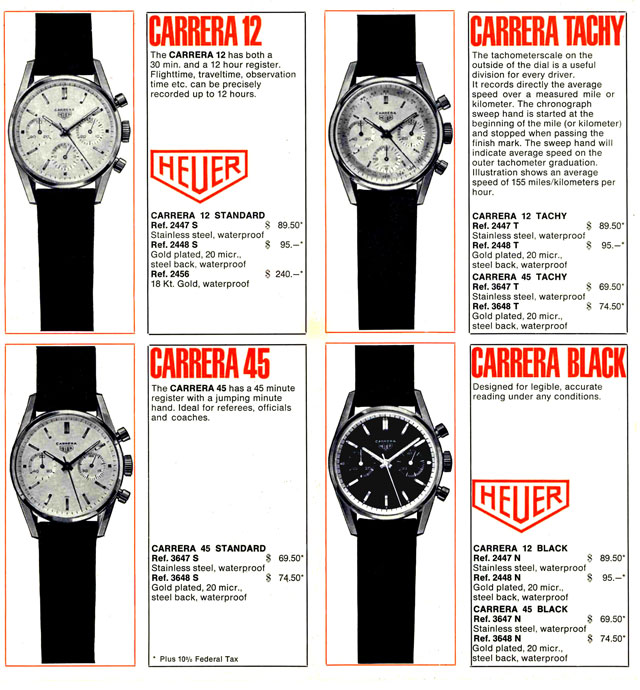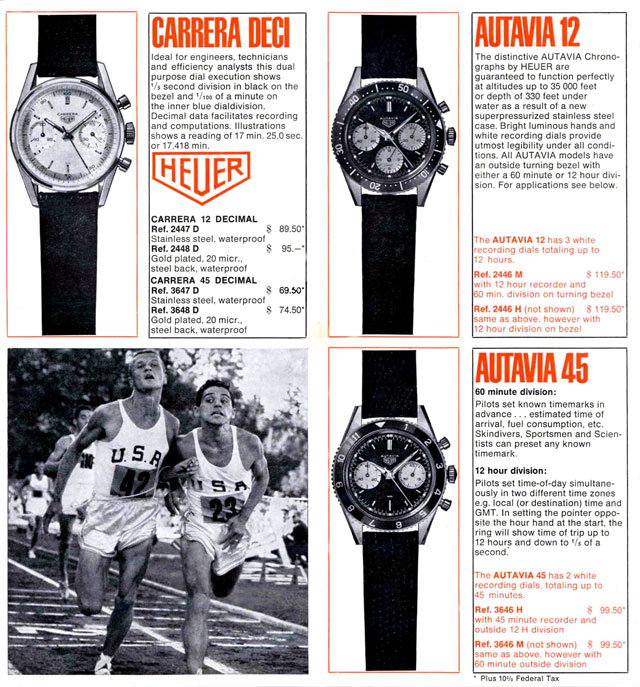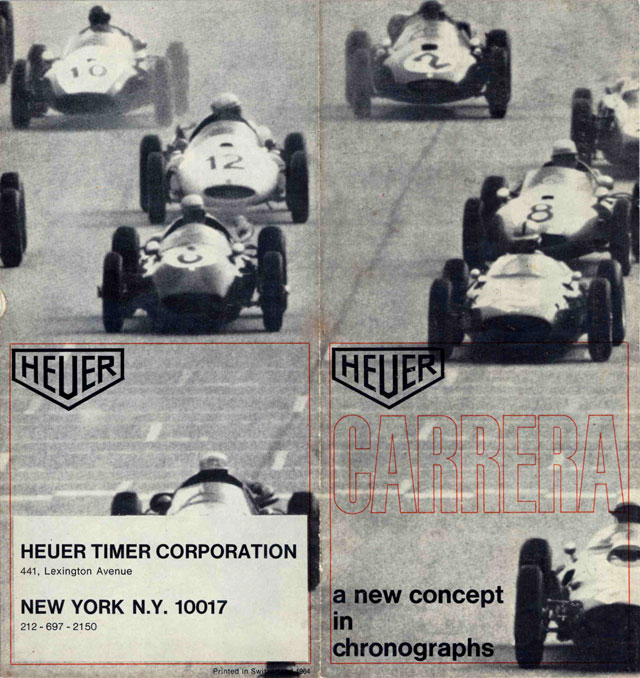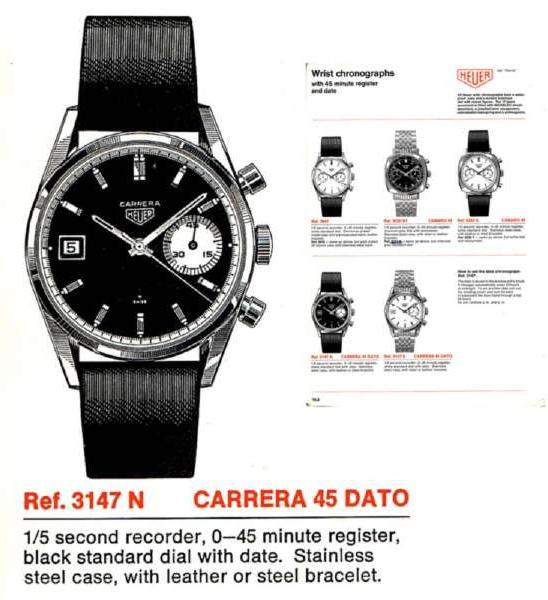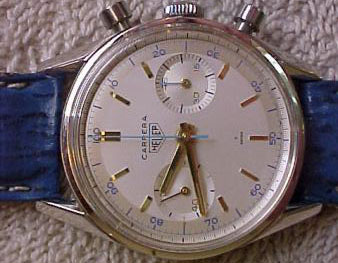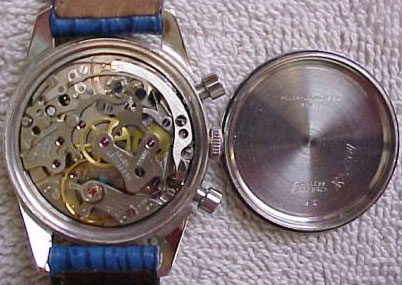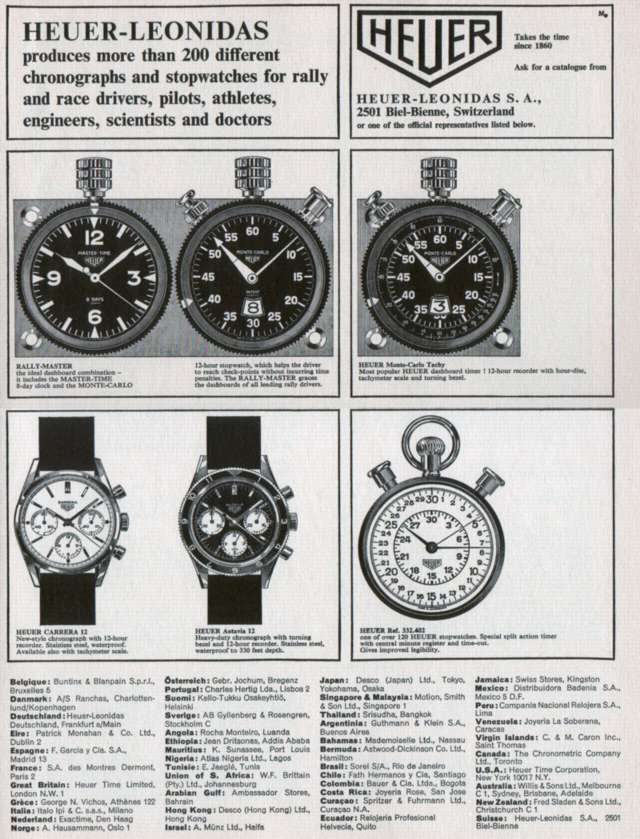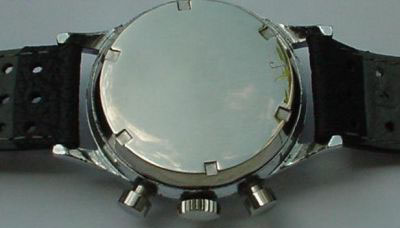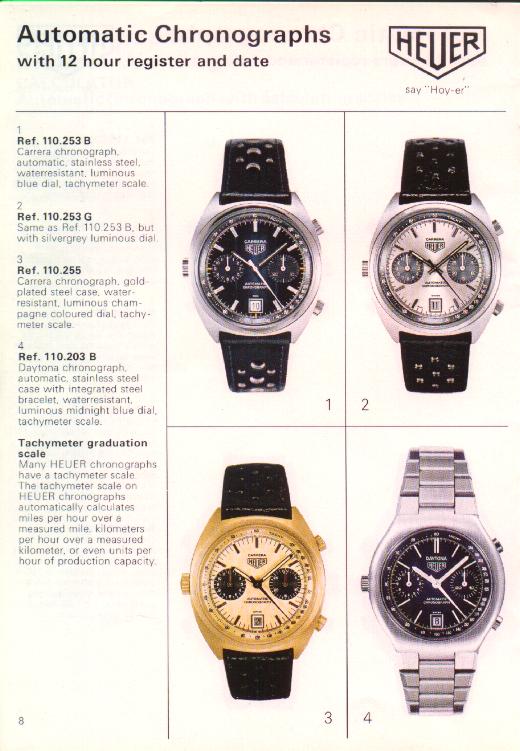 Heuer Carrera Chronographs:
Heuer Carrera Chronographs:
 - A
Brief Overview: Then, Now and the
Future:
|
- A
collaboration between
- Matthias
Liebe-Kleymann
 & Chuck
Maddox
& Chuck
Maddox

- Based on
a thread from 19 June
2002,
- Last
Revised: 14 June 2005, 19:12
GMT.
- Certain
Rights Reserved.
|
- Top,
In
The
Beginning,
- The
1960s,
The
1970s,
- The
1980s,
The
1990s,
- Now
and the
future...,
- Addendum,
Author's
Notes,
- Certain
Rights Reserved
|
|
Le
Carrera Panamericana Rally Mexico
In 1950, Mexico was
about to compete its section of the great
Pan-American highway. To celebrate that event,
it was decided to create a motor race on the
3,500 km distance of the highway from the border
of Guatemala and the United States. From 1950
through 1954, "Le Carrera Panamericana
Rally Mexico" was held five times. And
five times the worlds greatest drivers traversed
the vast expanse over terrain that varied from
deserts, prairies, mountains and tropical
jungles. A legend was born.
|
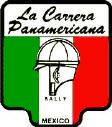
|
- Introduced in 1963,
Carrera was the first Heuer line of watches
with it's own brand name.
|
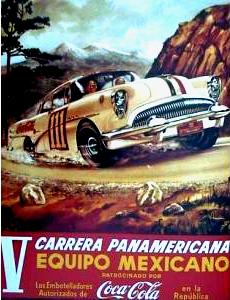
|
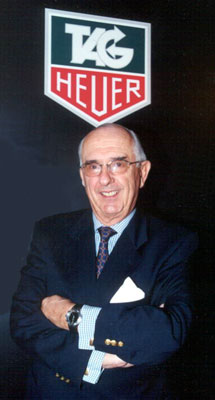
Photo
courtesy of Eric So
|
Although the Carrera was
a evolution in terms of design for Heuer, its
look was completely distinctive when compared to
the commonly seen and sold chronographs of the
1940's and 1950's. Jack Heuer (pictured at
left), the CEO of the company, wanted a watch
with an excellent readability. So he printed the
1/5 sec scale on the "rehaut" (the inner bezel)
of the watch. Tachymeter or pulsometer scales
were not placed in the centre of the dial (a
typical design feature of 1940's and 1950's
chronographs), but formed an outer ring around
the five minutes markers. The dial immediately
looked bigger and cleaner.
|
|
It's fair to say that
Heuer was already moving in this direction prior
to the first formal naming of a Carrera model.
The line was in continuous production until the
late 1970's/early 1980's in one form, model,
style or another. Design changed with the taste
of the times from classical-elegant, round case,
small lugs (until mid 1960's) to, well 1970's
style - large and fancy cushion cases. The last
vintage Carreras in the 1980's showed more
modern designs like the contemporary Lemania,
Omega or Porsche Design watches.
|
|
|
This article is an
attempt to show the origins, the growth, the
seeming death and rebirth of this classic
"tool-watch" chronograph. The Heuer Carrera
chronograph is sometimes overshadowed by it's
contemporaries, but it deserves recognition and
respect from the watch community.
|
|
|
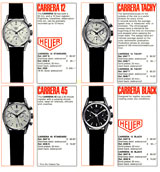
|
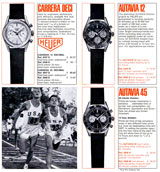
|

|

|
|
|
|
-- A
Heuer Carrera Catalog printed in
1964
|
|
- In the early years
Heuer used the classically designed
column-wheel movements in the Carrera.
Among them Valjoux 72
(three register: sweep second, 30
min.-counter,12 hour counter), Valjoux 92
(two register, sweep second and 45
min.-counter) and also the Landeron 189
without column wheel (one register: 45
min.-counter, date, no sweep second), this
version is very uncommon, and rarely
seen...
Here are a couple of
'60's Style Carreras:
|
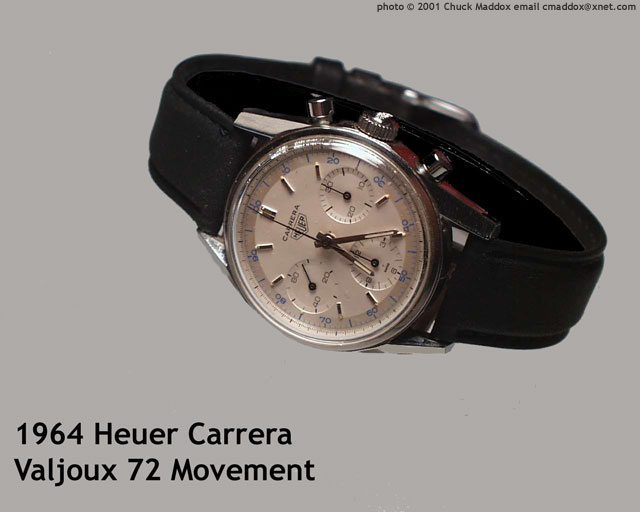
|
|
|

|
|
-- An uncommon
Carrera 12 Black w/White Sub-dials.
|
|
|
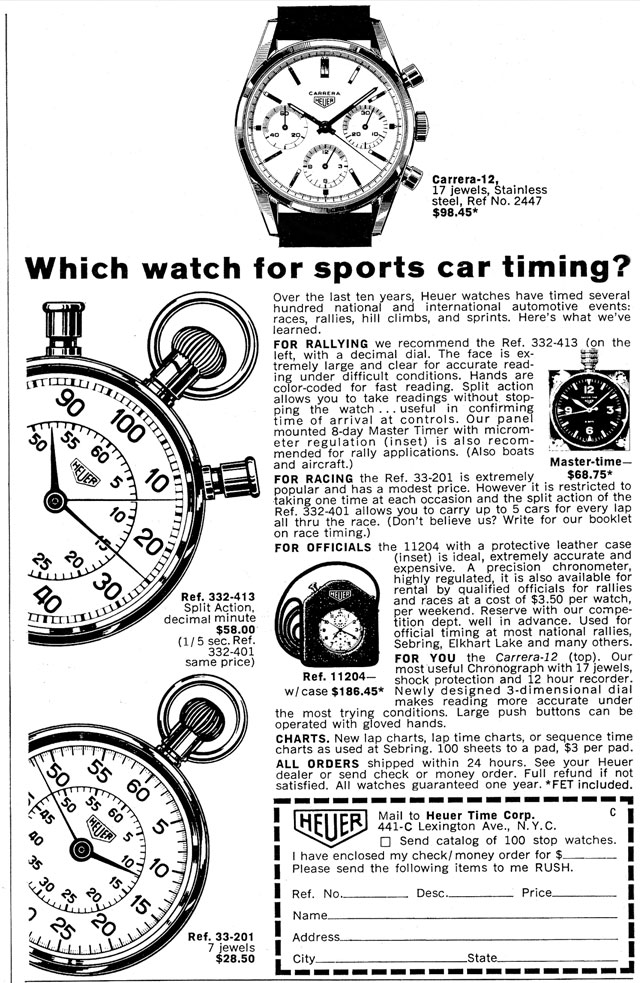
|
|
-- Heuer Ad
from October 1964 Issue of Car and Driver
Magazine (click to open a large {500k+} version
)
|
|
|
|
A recent Heuer Autavia
acquisition by Chuck yielded a Heuer World Wide
Service booklet. Generally Heuer shipped
non-model specific booklets with watches it
sold. Thus the booklet included with an Autavia
12 would be identical to one included with a
Carrera 12. The nice thing about this is that
this manual is generic enough that not only does
it serve as a manual for any Heuer equipped with
a Valjoux 72 movement, it also can be used as a
manual for any make Valjoux 72, or 726 movement,
and the instructions would essentially be the
same for the Omega Speedmaster's and Tissot
T-12's using c.321 and c.861 movements... A
portal to a web page with scans of this document
follows:
- Heuer
World Wide Service
Booklet:
|
|
|
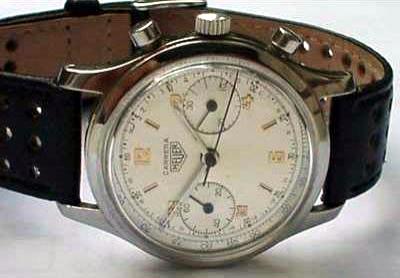
|

|
|
A
rather uncommon Carrera Landeron
189
|
|
|
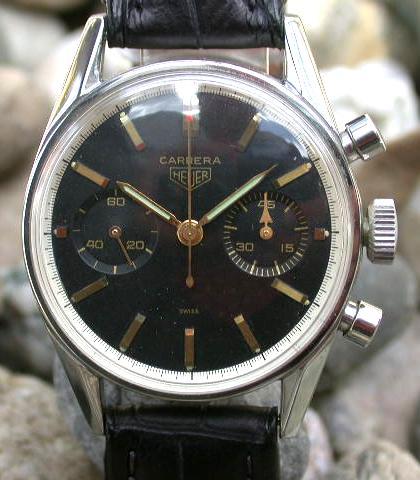
|
|
Matthias'
Carrera 45 Valjoux 92
|
|
|
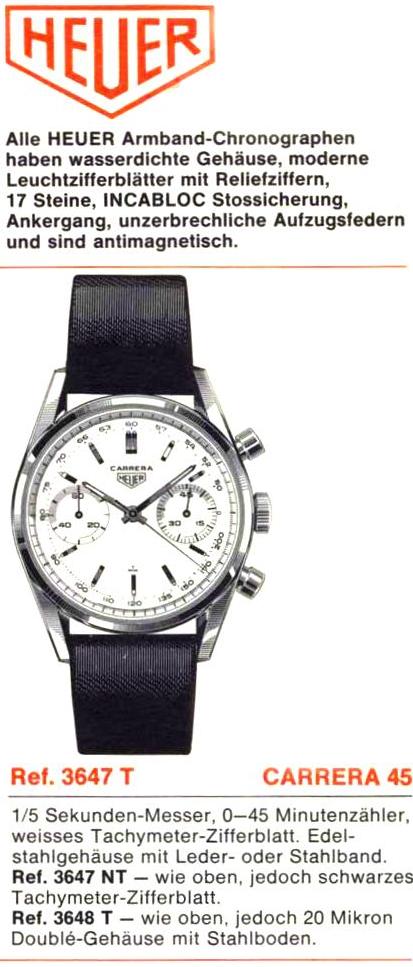
|
|
From
an old catalog
|
|
|
Later Heuer also used
the more economically constructed cam switched
Valjoux 773x movements like the one pictured
here:
|
|
|

|
|
Valjoux
773x
|
|
|
|
|
Heuer during this epoch
often produced watches with little rhyme or
reason. Actually, that's a bit incorrect, Heuer
during most epochs often produced
watches with little rhyme or reason, and the
1960's were certainly no exception. It seems
that if they could produce a
certain model and thought they could sell it,
they did produce it. So one sees some
particularly weird Carreras floating around...
For they were, well, odd times. So often it is
difficult to tell for certain if a certain hand
is proper or not.
|
|
|
-
|
|
|
After 1969, while Heuer
continued to produce and market manual wind and
even quartz models, the main thrust of their
efforts were with the newly introduced automatic
movement Cal. 11/12 and later the Cal 15 was
used.
Here is here how Heuer
introduced the new Carrera in
advertisement:
|
|
|

|
|
|
|
Well, truth is that
Heuer didn't really “move” the crown.
The Calibre 11 family was the first modular
chronograph construction: a chronograph module
made by Dubois-Depraz was attached to a
Büren micro-rotor movement. To fit, the
chronograph plate had to be rotated by 180
degrees. So the strange placement of crown and
pushers was a technical necessity and not a
tribute to the self-winding feature. So it was a
change made out of necessity, not choice.
Jeff
Stein, an avid Heuer collector, and as of
February 13 2003 the owner of OnTheDash.com
website discovered the "beta" version of this
article and was kind enough to send the
following scans for inclusion for this
article:
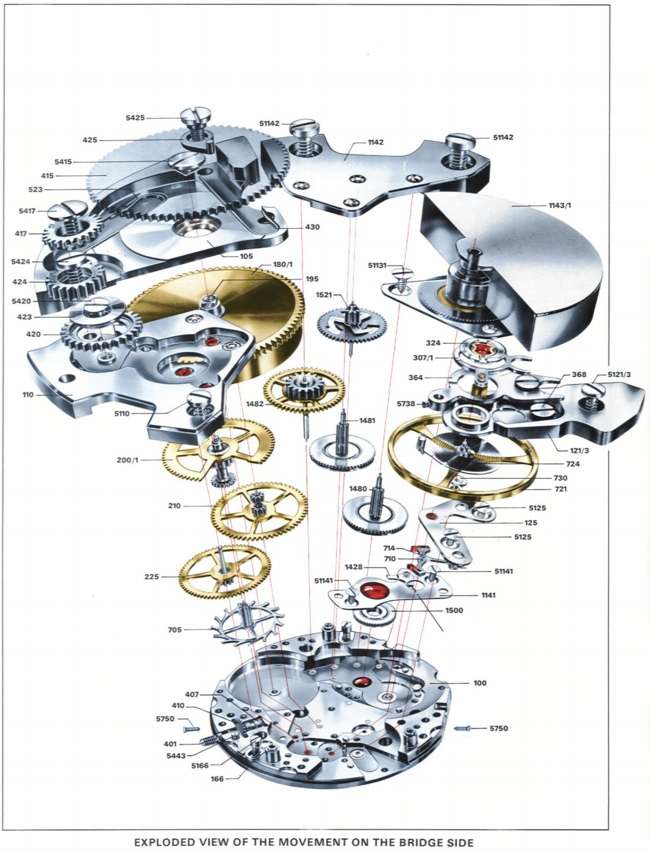
|
|
--
click on the picture to open a full
sized version of this picture in a new
window...
|
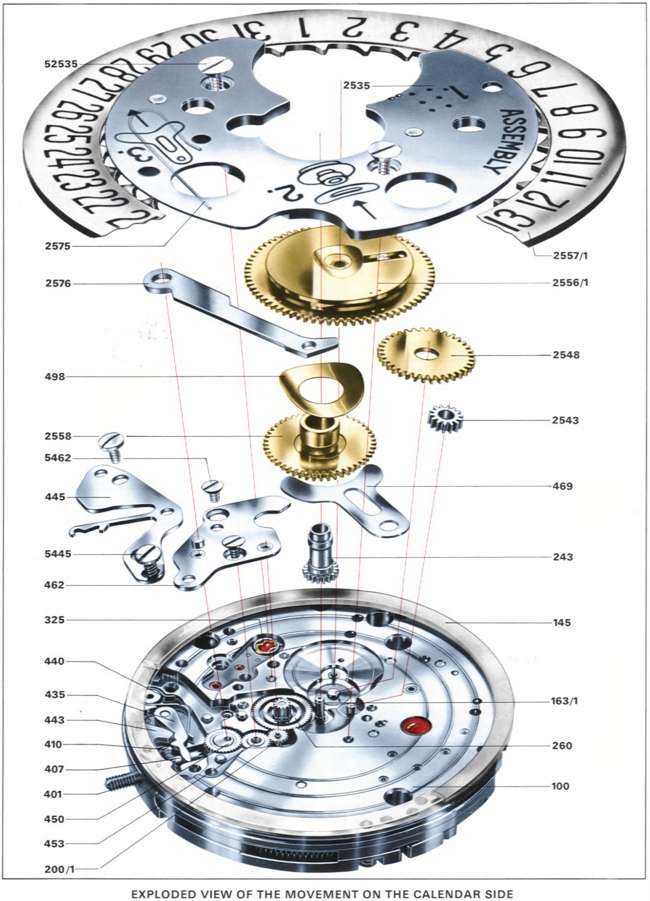
|
|
--
click on the picture to open a full
sized version of this picture in a new
window...
|
|
|
|
Special thanks to Jeff Stein for his
contribution to this article. I feel it
adds greatly!
|
|
|
A search of information available on the race
for the first automatic chronograph reveals
several very useful articles available on the
Internet. So we will not repeat those efforts in
this article. Three very good articles are:
1969,
World First Automatic
Chronograph
by Boon (no email address provided),
The
Race for the First Auto-Chrono
Movement
by Ignacio,
and Christoph Ozdoba's
A
Brief History of the Automatic
Chronograph.
A recent Heuer Valjoux
7750 acquisition by Chuck yielded a Heuer
Automatic Chronograph Instruction Manual which
covers both Heuer Valjoux 7750 Movement
Chronographs and Micro-Rotor Movements. A portal
to a web page with scans of this document
follows:
- Heuer
Automatic Chronograph Instruction
Manual:
- The
English language text begins on page 3 with a
diagram for use with the Micro-Rotor movement
on page 12.
Here are a couple of
micro-rotor Carreras gleaned from the
net:
|
|
|
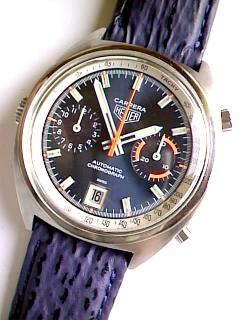
|
|

|
- Calibre
12
|
|
Two
shots of a Calibre 12
Carrera
|
|
|
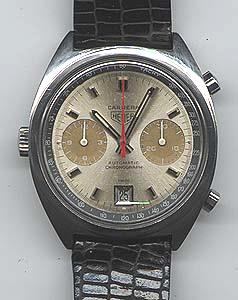
|
|
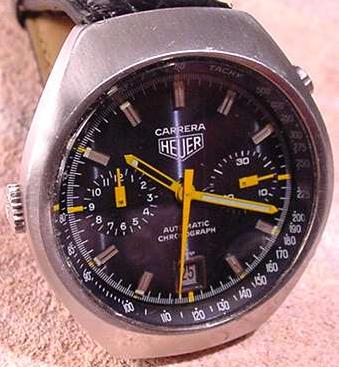
|
|
Another
Calibre 12
|
|
Second
Shot
|
-
|
- One of the
interesting things about Heuer is
that since they were seemingly
always experimenting with the looks
of their watches either they
innovated many things or were so
quickly adaptable to perceived
trends, oftentimes it becomes
muddled as to who truly was first
out there with an innovation. In
addition to the aforementioned
uncertainty with the honor of having
announced the first automatic
chronograph wristwatch movement, we
also have a very early example of
PVD coated Stainless
Steel...
|
|
|
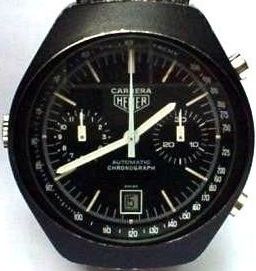
|

|
|
At this point
it remains unclear who was the first
producer of a "Black Watch"... Heuer or
Porsche Design/Orfina…
|
|
|
|
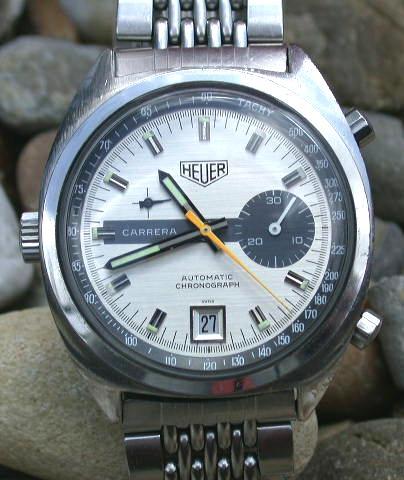
|
|
Matthias'
Calibre 15 Carrera
|
|
|

|
Perhaps
the ugliest "Carrera" in
captivity!
|
|
Definitely
Coyote-Ugly!,
and most certainly a
Frankenwatch...
|
|
|
|
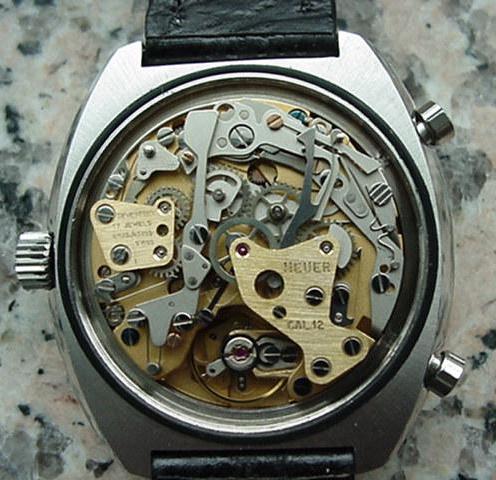
|
A
Cal 12 movement (Although it's in
Matthias' Heuer
Montreal)
|
|
The
four different types of Micro-Rotor
Movements…
|
|
Calibre:
|
Description:
|
|
c.11
|
first
member of the family with a 19,800
hourly beat rate, only in production
for one year - (two register: 30
min-counter, 12 hour counter, date, no
sweep second)
|
|
c.12
|
better
winding system, 21,600 beat rate (same
layout as the c.11)
|
|
c.14
|
c.12
with with additional GMT hand
|
|
c.15
|
with
sweep second in place of 12 hour
counter.
|
|
|
|
Note:
|
There
is no Cal 13, perhaps because in many
parts of the world the number 13 is
regarded an "unlucky number"...
|
|
-
- In the
early 1980's Heuer also produced
a cushion cased Carrera sporting
a Lemania 5100 under the dial. It
is significant in that it was
Heuer's first use of a Lemania
chronograph movement. This
particular chronograph is one of
Chuck's favorite and more
frequent daily wearers. It's dial
is exceedingly readable, even
more so than all the Omega
Speedmaster c.1045's (Lemania
5100's) save the Moonwatch case
model (ST 376.0822), which is an
exceedingly readable chronograph
in it's own right...
-
- Perhaps
this is one of the last "real" or
"Old Heuer" watches. Like most
European watch manufacturers
Heuer was hit hard by twin blows
of the quartz-boom and the
"Japanese watch invasion". In
1984 the company was sold to
Akram Ojjeh TAG-Group. The brand
name changed to TAG-Heuer and
nearly all the old model names
were replaced by numbers.
TAG-Heuer continued to sell the
old models with Heuer markings
until stock ran out of those
dials. When they still had
ebauches and other components
they would sell newly produced
"TAG-Heuer" models with the new
logo in place of the old "Heuer"
logo on the dial. Some notable
examples are the 510.5 series of
"Pasadena" cased Lemania 5100
Chronographs, and the Pilot's
Chronographs. The latter remained
in the product line largely
unchanged through at least 1995
when a switch was made in it's
quartz movement. Once these
components were depleted to a
certain level these models were
discontinued for the most
part.
-
- At this
time Heuer produced at least two
distinct versions of the 5100
Carrera, the 510.523 Stainless
Steel version as shown at
right.
|
|

|
One
of Chuck's Heuer Carrera
5100's Ref: 510.523
...
|
|
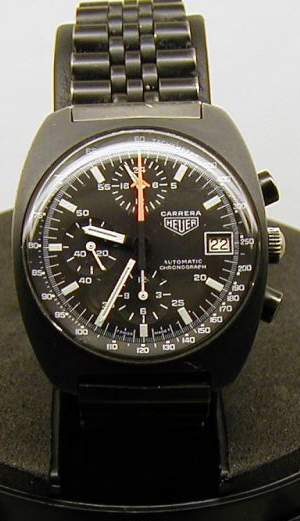
|
- Chuck's
Heuer Carrera 5100's
Ref:
510.511
|
|
|

|

|

|
|
(For
the history of the company
see: Brunner/Sich:
"Heuer/Tag-Heuer", Editions
Assouline, Paris
1997)
|
|
|
|
|
|
|
Some of the
notable items of interest with these
models is that neither the 510.523
or 510.511 possess a signed crown
like most Heuer's of this era. I own
three total of these two models,
none of them, nor any other example
I've ever seen for sale has had a
Heuer or TAG-Heuer signed
crown...
Additionally,
while the 510.511 came most often on
a "Jubilee" styled bracelet with
five-element "half-moon" shaped
links, the Stainless Steel 510.523
model came with a mainly flat link
bracelet of a similar style to
bracelets used on Micro-Rotor
watches in the 1970's and the
Carrera's other 5100 cousin's the
510.50x models, sans any PVD or
bead-blasted finish. Also of note
both of my 510.523's came with
"TAG-Heuer stamped clasps. This
would lead me to believe that the
510.523's production either started
later than the 510.511 or ended
later. Below is a catalog page from
a 1985 Heuer catalog that represents
a transition for the firm. The
catalog is clearly marked "Heuer"
and every single watch and reference
within is of "Heuer" with the
exception of the first
page...
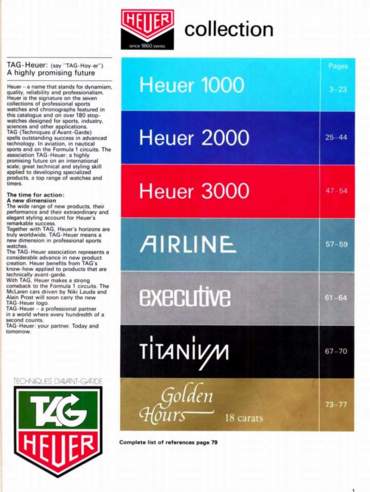
Scans of these pages of the
1985-1987 Heuer Catalog and Price
list courtesy of David Alstott who
lent this catalog (and many
others to Chuck over the Winter of
2002-2003)...
|
|
|

|
A glance at the price sheet, dated April Fools day 1987,
shows the pricing of the Carrera models to be lower than the
other 5100 models in the product line at the time, namely
$415 on Bracelet, $380 on a Strap (click
on the graphic for a larger version to open):
 
- Heuer
Automatic Chronograph Instruction Manual for Lemania
5100:
-
-
-
|
|
The story could well
have ended then and there. Under new management,
Heuer was recast as TAG-Heuer. Old lines were
dropped, new ones created. TAG-Heuer
transitioned from a largely "Tool-Watch"
manufacturer specializing in Chronographs,
Stopwatches and sporting events timing, to a
luxury watch manufacturer with an emphasis on
"avanté garde" design. Hence the name
"Techniqués d'Avanté
Garde".
While the new product
line achieved great financial success, it came
with a cost. Many people who remembered and
valued "the old Heuer" were not so keen on the
direction that the new management were set on.
For many years there was not a Carrera model, as
the often plain, austere and older styling did
not mesh well with the bold styling of the lines
added after the TAG takeover like the S/EL and
6000. The Carrera line was largely forgotten
except by those who had owned one, or perhaps
wished they could find one to purchase.
Eventually, towards 1997/1998, TAG-Heuer finally
realized that the roots of the brand was still
cherished and had retained great salability and
launched a "Classics" series of watches. The
first "new-old" model was the 1964 Carrera
Re-Edition.
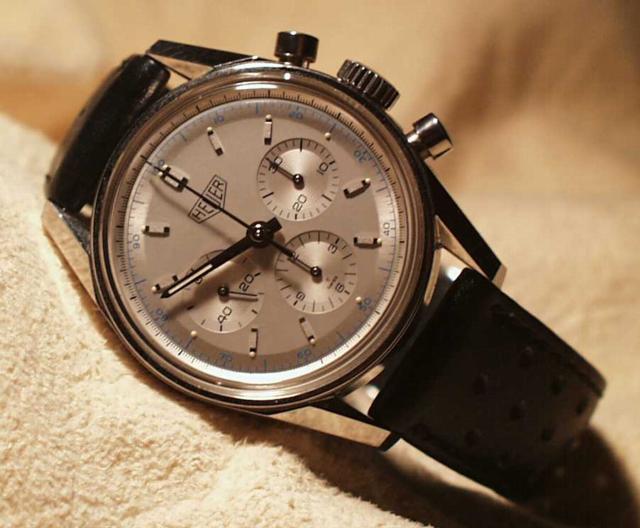
|
|
--
Chuck's 1964 Re-Edition Carrera
Silver Dial. Note the lack of
"Carrera" on the dial and the
Silver not white color of the
dial
|
- At first three new
Carrera "Re-Editions were offered for sale to
the public in a case and style nearly
identical to the original 1964 model, which
is now widely considered a classic by most
collectors:
- In 18k Yellow
Gold
- In Stainless Steel
with a Silver Dial
- In Stainless Steel
with a Black Dial
-
- For the most part
the Re-Edition models are a fairly close
approximation of the 1964 Heuer Carrera as
shown in the catalog near the beginning of
this article. Internally, the original models
were powered by a Valjoux c.72 movement. A
venerable and very popular column-wheel
mechanical movement used by nearly every
major watch manufacturer at one time or
another including Rolex, with the only
exception seeming to be Omega and Tissot. The
Valjoux 72 was the counterpart and main
competitor/rival of the Lemaina movement used
in the Speedmasters of the same epoch known
to most Omega owners/collectors as the c.321
movement. Valjoux ceased production of the
c.72 movement at some point in the 1970's to
concentrate on production of the 7750 family
of movements which it considered to be the
next big then. They seem to have been proven
correct on that one.
-
- So when TAG-Heuer
sought to re-release a version of the 1964
model, they ironically choose the movement
that replaced the original movement's main
competitor, the Lemania c.1873, known to most
Omega fans as the c.1861 movement which power
the current Omega Speedmaster Professional
Moonwatch. The level of finish on the
movements of the Re-Edition Carrera and the
Moonwatch are comparable, nearly
identical.
-
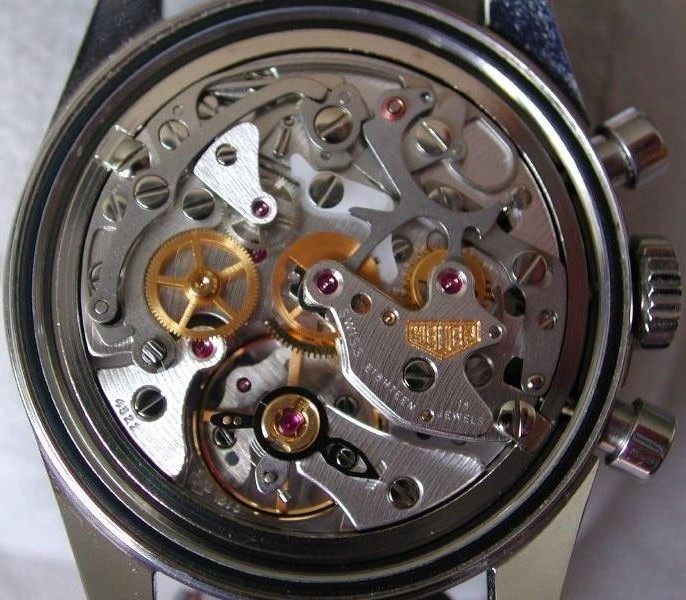 -
- So once again anyone
could visit their local TAG-Heuer Dealer and
purchase a "Heuer Carrera" to wear while
driving a vintage car through Mexico... The
Carrera Panamercana rallye is once again
alive since it's revival in the late
1980's.
-
- So how did the
Classics line fair? The Carrera Re-Editions
(along with their Monaco Re-Edition line
mates) were tremendous sales and critical
successes, and TAG-Heuer quickly added
additional models to each classic product
line. First were two new variants of the
existing Chronograph line with "Daytona
Rings" added to the sub-dials of a new Black
and Copper dial version:
-
|
|
These models are
identical to the previous Stainless Steel cased
models with the exception of the dial and model
number. The movement remains the Lemania 1873
used previously.
In addition to these two
chronograph models, TAG-Heuer choose to add two
models (with attendant dial/strap variations to
complement the chronograph models...
These new models are
"Classics" in name and styling only. There are
no direct or indirect relation to any models
that Heuer produced in the 1960's or 1970's...
At the time Heuer concentrated entirely on
Chronographs, stopwatches and sporting event
timing. These new models sported fairly
commonplace ETA movements in Carrera cases with
newly designed dials for the Classics
line.

|
|
--
Photo provided by Jorge
Merino
|
|
|
|
|
|
|
|
TAG-Heuer is at an interesting
crossroad's... The near monopoly which Swatch Group holds on
the production of watch movements, with Swatch owning not
only ETA and Valjoux, but the recent addition of Lemania to
their juggernaut has had ripples across the entire
industry... Shortly before the turn of the millennium the
luxury goods manufacturer Louis Vitton Moet Hennesy
purchased TAG-Heuer which had been briefly traded publicly
on the stock market. With the bulk of Lemania's production
going to Omega for use in it's Speedmaster Moonwatch line it
was often very difficult for TAG-Heuer to secure the
necessary movements to meet demand on the Carrera Re-Editon
models, although they remain in the lineup. Other Classics
line models, the Monaco and the newly added Monza models
sported ETA movements with Dubois-Depraz chronograph
modules. The difficulty of obtaining Lemania movements,
caused LVMH to purchase the Zenith Watch company as the
Millenniums changed to secure the capability to produce
their own movements.
The latest announced model of the
Monza sports a Zenith manufactured movement based largely on
the famous "El-Primero" movement that was a competitor in
the virtual dead heat race to produce the first automatic
Chronograph movement. It's a bit ironic that while it can be
argued that the Breitling, Hamilton-Bruen, Heuer consortium
was the first to cross the line and that both the Zenith and
Seiko camps have their advocates as well, that it's quite
possible, even likely, that soon we'll see a Heuer Carrera
sporting a movement based on it's arch-rival, once
again.
Where this saga ends is hard to say.
TAG-Heuer is a very successful company. In many ways, namely
profitability, more successful than it ever was prior to
TAG-Heuer years. It has a good reputation amongst first-time
buyers in the luxury Swiss watch market. In fact if you ask
many first time buyers they consider their TAG's to be every
bit the watch that Rolex is, but not as staid in it's
designs.
But in the hearts and minds of many
in the watch industry and hobby, TAG-Heuer has strayed so
far from it's roots that many people who have been
interested in watches for sometime never even consider the
Classic models. Many feel that it would be a good strategy
for TAG-Heuer to center it's sales strategy on two product
lines... The TAG-Heuer line which would consist of the bulk
of the existing product lines: 2000, 6000, Link, Alter Ego,
Kirium, and Specialist lines, and a revived "Heuer" line
which would consist of the existing Classics line with Heuer
dials/crowns/clasps/etc. and new "homage" models, perhaps
based around Zenith movements.
One piece of recent news that serves
as a beacon for potential hope in this regard is that
TAG-Heuer has recently secured the services of Jack Heuer,
the driving force behind the original Carrera all those
years ago. It is the hope of many that Mr. Heuer will forge
a revival of the aspects of no-nonsense design that he
championed previously.
In many ways, the story of the Heuer
Carrera is about coming full circle. Like the great Mexican
road race that served as it's inspiration, the Heuer Carrera
has been about inspiration, growth, decline, memory, rebirth
and growth. Coming full circle to embrace and incorporate
aspects of it's competitors and rivals. The potential for
TAG-Heuer to move to a new tableau is there, the pieces and
components are there, the finances are good, once the
current economic uncertainty is overcome their positioning
is good, and they have the man who started it all is back in
the fold. Let's hope they move wisely with an eye not only
on the short-term but towards the horizon as well.
Just as this article was nearing
completion, TAG-Heuer announced a new edition of the
Carrera. This model is not a re-edition as it is unlike any
previous Carrera ever produced:

|
Caliber
17 (not the Zenith - that's a Caliber 36),
MSRP is 2,150 Euros. --
Photo provided by Jorge
Merino
|
- As you can tell by looking at
the other various models we have presented in this
article these are unique watches to the Carrera history.
As pointed out by Jorge in his post, the movement is not
a Zenith El-Primero based movement, but rather (because
of the arrangement of the sub-dials a ETA2890-A2 with a
DuBois-Depraz piggyback Chronograph movement module. It's
interesting that TAG-Heuer is calling this movement the
Caliber 17, perhaps a tip of the hat to the earlier
c.11-15 movements that also had Dubois-Depraz
inspiration... Chuck discusses the ETA-DD piggyback
movement in his article
on the Omega Speedmaster Reduced
which you may read by clicking on the supplied link. It's
a shame that TAG-Heuer didn't incorporate a Zenith based
movement in this Carrera, for it would be a world beater.
The ETA/D-D movement is significantly less desirable. But
hopefully Zenith will be able to increase production and
we may yet see some Zenith-Carreras.
|
|
|
|
|
|
One of the more difficult things to
do with vintage Heuer Chronographs is authentication of a
watch. Since Heuer produced watches with many variations of
dials, hands, etc. it is often difficult or nearly
impossible to be certain that certain aspects of a given
watch are correct.
However once in a while a watch
comes along that it pretty easy to spot as a "Put-Together".
For example this watch recently appeared for sale on eBay
from a UK seller:
|

|
|
A "de-construction" of the
dealer's text:
Heuer Carrera 1973 automatic Lemania movement
(well... The
Lemania 5100 movement dates from 1973 I doubt the
watch does), this watch has
everthing, chronograph, date and day
(I don't see
day do you?),G.M.T.hand what
else do you need? black original dial with orange
second and G.M.T. hands
(well there
is actually only one GMT hand and it isn't orange)
(main timekeeping hands are wrong {non-original}
too),steel case and screw
back,this has same movement as I.W.C. Porche
design (IWC
never used a Lemania 5100, but Orfina-Porsche
Design did) it is very rare
model (yes,
the 5100 based Carrera does seem to
be),it has
(non-original)
blue internal bezel,new glass
(also
non-original) and was
recently serviced,it comes on a Heuer steel strap
I'm unsure if its original but it looks good on
this watch.
(Yes, I de-construct all dealer ad's in this
manner…) Also looks like this watch has had a
very rough life...
|
|
|
--
Funky 1980's style Heuer Carrera 5100
|
|
Aside from it's rough condition, there are a couple of
things wrong with this example. The main timekeeping hands
are incorrect, the under Plexiglas crystal has been replaced
with a totally useless non-rotatable Compass/Slide Rule
outer bezel of unknown origin (could be Breitling, Citizen
or Seiko, or gosh! I don't know... Pulsar maybe? It's very
screwy). I'm uncertain about how restorable this example is,
but if my (Chuck's) personal experience is any indication,
my Heuer Carrera 5100 has been at Pro-Time (TAG-Heuer's
national repair facility in New Jersey) since early May and
it's nearly August for a crystal change and the addition of
two links. So I would think restoration of this example
would be a rather lengthy project. Buyer beware!
|
|
|
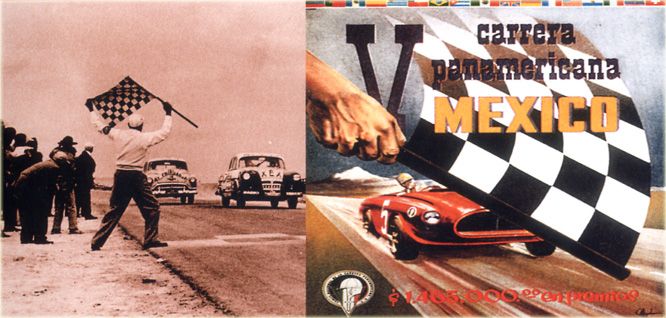
|
|
Carrera Panamerica Mexico
Scans courtesy of Ralf
Beinenz
|
|
|
|
|
- This article is a collaboration
between Matthias
Liebe-Kleymann and
Chuck
Maddox based on a series
of replies to a query for information on Heuer Carreras
posted on the TimeZone Omega Forum on 19 June 2002 by
Henrik E. Due to the timing of the posting, in the wee
hours of the morning, and due to Matthias being located
near Frankfurt he replied to the query first with textual
information that compromises much of the copy in this
article. By the time Chuck (who's located near Chicago in
the USA) was aware of the post there were merely a few
minor textual additions and a number of graphics. In the
discussion which follows we decided to pool our resources
for this article.
Much of the copy was written by
Matthias, a sizable chunk of the graphics also were provided
by him. Much of the text did originate from Chuck's keyboard
based on his experience, information gleaned from various
websites and documents on the subject. The remaining
graphics, with the exception of the previously credited
photograph by Eric So and scans by Jeff Stein and Ralf
Beinenz, were provided by Chuck who also handled the HTML
work and hosts this article. Special thanks to Jorge
Merino for his rapid response to
Chuck's request for a scan of the new Carreras just
announced and for his additional scan of two Lemania c.1873
based Carrera Re-Edition chronographs . Chuck would also
like to thank Walter Joerg for his assistance with the
Heuer-Leonidas scan...
Special thanks are due to Chris
Wooley who also provided photos and or insight on the topic
at hand... Without which the article would look and read
significantly different, Richard Sexton who helped with
back-checking some of the information presented in this
article and David Alstott who lent Chuck a wide variety of
materials during the winter of 2002-2003 that included the
1985 Heuer catalog which was reproduced for the 1980's
section.
|
|
|
|
|
|
Permission for
personal, educational or non-commercial use is granted as
long as this notice and the document remains intact and
unaltered. The authors retain all other rights not
specifically mentioned here... For all other use please
contact the authors.
Disclaimer: Opinions are our own and
knowing us should be taken with a grain or two of
salt...
|

|











